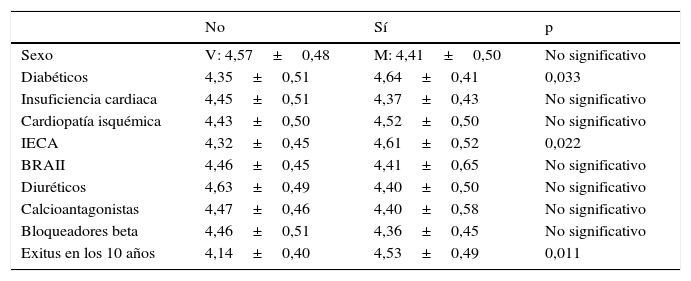Existen crecientes evidencias de que pequeñas variaciones dentro del rango normal del potasio, entre 3,5-5mEq/l, se asocian con mortalidad.
ObjetivoConocer si existe asociación entre el nivel de potasio sérico (Ks) basal con la mortalidad en una cohorte de ancianos hipertensos.
Pacientes y métodosEstudio observacional retrospectivo, de pacientes que disponían de Ks en un periodo de estabilidad clínica, durante su reclutamiento entre enero-abril de 2006 y seguidos durante 10 años. Se estudiaron 62 pacientes estables, con edad media de 82,19±6 años (rango 69-97); 74,2% mujeres, 33,9% diabéticos, 20,3% con antecedentes de insuficiencia cardiaca y 19,4% de cardiopatía isquémica; un 44,3% recibían inhibidores de la enzima convertidora de angiotensina (IECA). Se registró la mortalidad acontecida durante 10 años. La estadística se hizo con SPSS15.0.
ResultadosCuarenta y nueve pacientes fueron exitus. El Ks tenía distribución normal. Los niveles medios basales y mediana de Ks fueron de 4,45±0,5mEq/l (rango de 3,1-5,5mEq/l). Los niveles basales de Ks eran significativamente mayores en diabéticos y en tomadores de IECA. Los pacientes fallecidos tenían niveles Ks mayores (4,53±0,49mEq/l versus 4,14±0,40mEq/l; p=0,011). La supervivencia por Kaplan Meier demostró que pacientes con Ks superior a la mediana y a P75 presentaron mayor mortalidad.
ConclusionesEn nuestro estudio los niveles Ks mayores a 4,45mEq/l se asociaban con mortalidad. En ancianos hipertensos, a la hora de seleccionar tratamiento antihipertensivo, se debería valorar individualmente el uso de IECA, con monitorización estrecha en los niveles de Ks y procurar mantenerlos en el rango medio de la normalidad (<4,45mEq/l).
There is increasing evidence that small variations within the normal range (3.5-5mEq/L) of potassium are associated with mortality.
ObjectiveTo determine whether there is an association between serum potassium level (sK) and mortality in a cohort of elderly hypertensive patients.
Patients and methodsA retrospective, observational study was conducted on patients who had sK levels available in a period of clinical stability during their recruitment between January and April 2006 and followed-up for 10 years. The study obtained a total of 62 stable patients, with a mean age of 82.19±6 years (range 69-97), with 74.2% women, 33.9% diabetics, 20.3% with a history of heart failure, Ischaemic heart disease was observed in 19.4% and 44.3% received Angiotensin Converting Enzyme (ACE) inhibitors. An analysis was performed on the mortality rate during the 10 year period. The statistics were performed using the SPSS15.0 package.
ResultsThere were 49 deaths. The sK had a normal distribution. Baseline mean sK levels and median were 4.45±0.5mEq/L (range 3.1-5.5 mEq/L). Baseline sK levels were significantly higher in diabetic patients and patients on ACE inhibitors. The patients that died had higher sK levels (4.53±0.49mEq/L versus 4.14±0.40mEq/L, P=.011). Survival estimated using Kaplan Meier showed that patients with sK levels higher than the median and P75 had higher mortality.
ConclusionsIn our study, sK levels greater than 4.45mEq/L were associated with mortality. When selecting antihypertensive treatment in hypertensive elderly patients,, the use of ACE inhibitors should be assessed individually, with close monitoring at sK levels and try to keep them in the lower limit of the normal range (<4.45 mEq/L).








